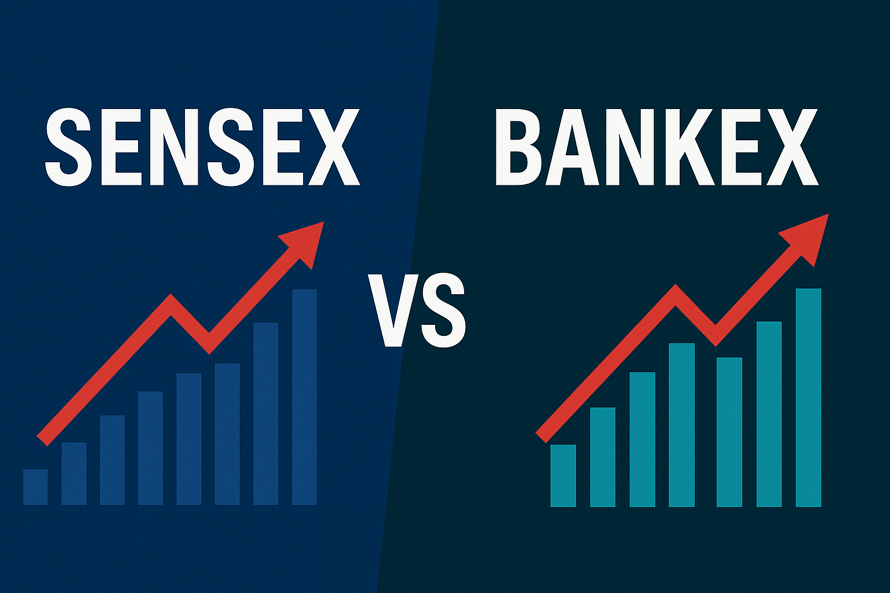
When the Indian stock market is mentioned, two big indices tend to be in the spotlight: the Sensex and the Bankex. Both belong to the Bombay Stock Exchange (BSE) but serve different purposes. Sensex reflects the top 30 companies in various industrial segments, providing a general market picture. Bankex, on the other hand, restricts itself to top banking shares.
Understanding Sensex vs Bankex assists an investor in learning the difference between the overall market performance and that of the banking industry. The comparison helps in making informed decisions regarding investments. If you are a novice or a professional investor, it is important to understand the difference between these indices to develop a prudent approach to the stock market.
What is Sensex? Definition and Market Role
The Stock Exchange Sensitive Index, popularly known as Sensex, is the benchmark index of the Bombay Stock Exchange (BSE). It monitors the performance of the 30 largest and most traded stocks listed on the BSE. When comparing Sensex vs Bankex, we must consider that the Sensex index tracks various sectors, whereas Bankex tracks only banking stocks.
History and Composition of BSE Sensex
Sensex is the oldest stock market index in India, introduced in 1986. It is a reflection of India’s economic development. The index is adjusted twice a year—in June and December. The lowest decline it has ever experienced was on April 18, 1992, when it went down by 12.7% due to a big financial scam.
Nevertheless, the Sensex has experienced considerable growth since 1991.
Calculation Method: Free-Float Market Capitalization
Previously, the Sensex total market capitalization was employed. As of now, it applies free-float market capitalization, i.e., only publicly traded shares are taken into account. For instance, a company is valued at $600 million and has a 50% float, then its free-float cap is $300 million.
Sectors and Companies Included
The index consists of 30 companies that represent different industries such as finance, IT, healthcare, and energy. It provides a wide outlook on the Indian economy and the health of its industries.
What is Bankex? Tracking India’s Banking Sector
The BSE Bankex is a sectoral index developed by the Bombay Stock Exchange (BSE). It monitors the performance of the major banking stocks in India. Bankex assists investors in understanding the performance of the banking sector in the stock market. It comprises both the private and public sector banks.
Purpose and Scope of BSE Bankex
The primary objective of Bankex is to provide a benchmark to the Indian banking industry. It enables investors to gauge the performance of the banking stocks collectively. This helps in making sector-wise informed investment decisions. The index is monitored by mutual funds, ETFs, and retail investors.
Method of Stock Selection and Rebalancing
Only the banking stocks that are actively traded on the BSE are included. It is selected on the basis of market capitalization and liquidity. BSE rebalances and reviews Bankex twice a year, in June and December. This makes sure that the index remains relevant and represents the prevailing market conditions.
Leading Banks in the Bankex Index
HDFC Bank, ICICI Bank, State Bank of India (SBI), Axis Bank, and Kotak Mahindra Bank are some of the leading banks in the Bankex index. These are banks with large market caps and are essential contributors to India’s economy.
Latest Index Performance as of May 13, 2025
By 2026, it is anticipated that India’s stock market will see $9.66 billion in transactions. But, before that, by May 13, 2025, there was a significant change in both the Sensex and Bankex. So, let us analyze it in simple terms.
Sensex at 81,149.18 – What This Means
The BSE Sensex closed at 81,148 on May 13, a decrease of about 1,282 points (-1.55%) from the previous peak of 82,430+ levels. This decline came after a historic spike the day before, which was fueled by a reduction in tensions between India and Pakistan. Profit-taking by investors following that significant rally was a major factor in the decline.
Bankex at 62,600.61 – Banking Sector Movement
Amid widespread weakness in the banking sector, the BSE Bankex, which tracks India’s top banks, dropped to 62,600.61, down roughly 1.15% from yesterday’s close of 63,209.95. With a weekly fall of about 1.7%, the one-day range was between 62,112 and 62,586. The decline was led by major players like HDFC Bank, SBI, and ICICI, indicating market hesitancy regarding financial stocks.
Key Trends in 2025 Market Movements
Amid global trade and inflation cues, the Sensex showed cautious gains in early June, ranging between 82,500 and 82,600. Public sector banks underperformed, but Bankex opened higher due to a recovery in banking stocks. Overall momentum remained subdued due to global uncertainties.
Sensex vs Bankex: Key Differences Explained
BSE is the developer of both Sensex and Bankex, which are stock market indices. While Sensex measures the performance level of 30 leading companies belonging to various industries, Bankex considers banking stocks alone. Investors should know the difference between Sensex vs Bankex.
Market Coverage and Sector Focus
Sensex consists of 30 large-cap, actively traded businesses across various industries like IT, energy, FMCG, and finance. It provides a big picture of the Indian economy. Bankex, however, comprises leading banking firms such as HDFC Bank, ICICI Bank, and SBI. It provides an industry perspective, being limited to the performance of banking.
Calculation and Rebalancing Rules
Sensex and Bankex are both computed by the free-float market capitalization technique. The list of companies in each index is reviewed and rebalanced on a regular basis. Sensex moves with the general market trend, whereas Bankex gyrates in line with the health of the banking industry.
Usefulness for Investors and Analysts
Sensex gives investors a sense of how the Indian stock market is performing. Bankex comes in handy in cases where one wishes to invest in or monitor the banking industry. The Sensex vs. Bankex comparison can be used to make sector-based investment decisions.
Practical Use Cases for Investors
The purpose of each index is different. The knowledge of Sensex vs Bankex is useful in making more intelligent investment plans.
Using Sensex to Benchmark Mutual Fund Performance
Sensex consists of 30 leading companies in different fields. Often, it is taken as the yardstick with which to measure the returns of mutual funds. When your mutual fund is performing better than the Sensex in terms of returns, then that particular fund is performing well. Sensex is also used by fund managers to fine-tune their strategy.
Using Bankex to Track Interest Rate-Sensitive Stocks
Bankex consists of banking stocks only. It is an indication of the performance of the banking sector. Bankex is used to monitor trends in the industry. Banking stocks are sensitive to fluctuations in interest rates. This assists traders and long-run investors to concentrate on rate-sensitive sectors.
When to Invest Based on Index Trends
When Sensex and Bankex are rising, it indicates confidence in the market. It could be a good time to invest. When the market is declining, it is good to wait or buy in small portions. The study of Sensex vs Bankex trends enables investors to cut short on risks and select the appropriate sectors.
Market Outlook and Future Trends
The stock market in India is set to record steady growth in the near future. The Sensex and Bankex indices are both gauges of investor confidence. However, they are impacted differently by different factors. Sensex vs Bankex comparison can provide an idea about the overall trend in the market and the banking industry.
Economic Growth and Its Impact on Sensex
India’s GDP growth has remained steady over the years. Increased consumption, government infrastructure investment, and a young workforce are some major factors. With the rise in the economy, firms in various sectors post increased profits. This has a direct impact on the Sensex, which is reflected in the superior performance across various sectors.
RBI Policies and Bankex Volatility
The Bankex index very much reflects the monetary policies of the Reserve Bank of India. The repositories and liquidity levels impact lending and borrowing by banks. If interest rates increase, Bankex can be volatile. Banks are also typical beneficiaries when rates decline because more loans are processed.
Global Influences on Indian Indices
Indian indices are also impacted by global developments such as oil price fluctuations, US interest rate hikes, and geopolitical issues. When global markets are stable, foreign investments increase. Global developments can influence both the Sensex and the Bankex.
Conclusion: Which Index Should You Watch Closely?
Your orientation should be based on what you want to invest in when deciding between the Sensex and Bankex. Sensex monitors the general market and provides a more comprehensive view of the leading businesses in India. Bankex, however, deals solely with banking stocks. Bankex is recommended if you are interested in monitoring the financial sector’s performance.
Sensex is more helpful in case of general market trends. Analyzing Sensex vs Bankex allows for pointing out the fact that various indices are used with different objectives. Pick the one that suits your sector interest to help you make an informed investment decision.
FAQs
Q. What is the difference between Sensex and Bankex?
Sensex represents the 30 leading companies on the BSE in terms of sectors. Bankex comprises only the major banking stocks. Sensex indicates the wider market trends, whereas Bankex indicates the banking performance.
Q. How many stocks are in the Sensex and Bankex?
Sensex consists of 30 large, financially sound businesses. Bankex is comprised of 10 leading banking stocks ranked by market capitalization. Both are BSE indices; however, Bankex confines itself to representing the banking sector.
Q. Can retail investors invest directly in these indices?
Retail investors cannot invest directly in indices. However, they can invest in index mutual funds or ETFs that mirror the performance of the Sensex or Bankex on the stock market.
Q. Is Bankex more volatile than the Sensex?
Yes, Bankex is generally more volatile than the Sensex. Bankex is vulnerable to changes in interest rate, monetary policy, and economic cycle.
Q. Which index reflects India’s overall market sentiment?
Sensex is a better indicator of India’s general market mood. It has leading businesses in varying fields such as IT, finance, FMCG, and manufacturing to provide a wider picture of the Indian economy.
Q. How is the Sensex calculated?
Sensex is computed by taking the sum of the free-float market capitalization of the 30 companies that constitute the index. It only uses shares that are traded and not the total shares outstanding, which provides a realistic view of investor sentiment and stock performance.
Q. What factors affect Bankex performance?
Interest rates, RBI policy, loan growth, asset quality, and macroeconomic health drive Bankex performance. Bankex movements are also largely affected by banking reforms, inflation, and financial results.
Q. Where can I track live Sensex and Bankex data?
The BSE India site and other financial news sites provide live data of the Sensex and Bankex.







